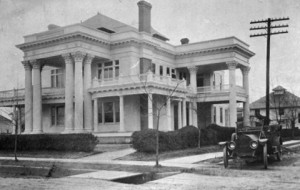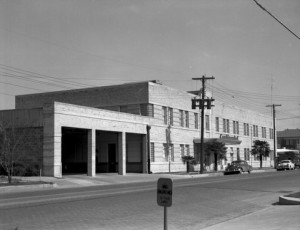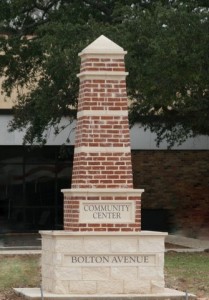
Big things are happening on Bolton Avenue. This historic transportation corridor is coming back to life thanks to the revitalization efforts of the City of Alexandria, local business men and women, and neighborhood groups.
For over a century Bolton Avenue has played an integral role in the life of our city. The street appears on city maps as early as 1897, when it formed the southern boundary of West Alexandria. Just five year later, by 1902, the city of Alexandria had expanded past Bolton Avenue thanks in part to the Alexandria Electric Railway, a streetcar line that ran down the middle of Bolton Avenue. The streetcar connected Levin Street and Jefferson Highway, later named Lee Street, on a route that circulated through downtown.

With the construction of numerous military training bases in the area and the subsequent influx of military men and their families just prior to and during WWII, Alexandria’s population grew exponentially. Residential neighborhoods expanded south of Bolton Avenue to what is now known as the Garden District. From 1920 to 1953, Bolton Avenue morphed from a grand residential thoroughfare to a thriving commercial corridor. An astonishing number of residences were demolished and commercial structures erected. Historic Sanborn Maps show that, in 1921, of the total 76 structures on Bolton Avenue, 71 were dwellings. By 1953, Sanborn Maps reveal that only 8 small dwellings remained on the far eastern and western ends of the street. The mansions around the central hub of Jackson Street had been demolished to make way for small, square, brick commercial buildings, many of which still exist today. In the wake of change, residential structures that represented the early twentieth-century growth of Alexandria were lost.

Urban renewal efforts of the 1970s again changed the character of Bolton Avenue. As all cities do, Alexandria continued to expand outward from its historic downtown core, this time growing toward MacArthur Drive. What was constructed in 1942 as a military transport route, within thirty years had become Alexandria’s newest commercial corridor and primary thoroughfare. The construction of the Alexandria Mall in 1973 clinched MacArthur Drive’s status as the city’s new commercial hub and confirmed Bolton Avenue’s demise as businesses slowly abandoned the once-thriving residential-turned-commercial corridor. As it did with the streetcar in the 1920s and the automobile in the 1950s, transportation again aided the transformation of Bolton Avenue. Traffic was re-routed from the congested, two-lane Bolton Avenue to the wider four-lane MacArthur Drive. Even travelers driving north and south through our state were diverted from Hwy 1 (Third Street to Lee Street to Bolton Avenue) to Hwy 71 (MacArthrur Drive) as they entered Alexandria. MacArthur Drive succeeded in decongesting the downtown streets and Bolton Avenue, but at a price to Alexandria’s historic transportation and business corridors.
Like so many cities, as Alexandria continued to sprawl and grow outward, the historic core of the city became increasingly blighted. Recognizing this trend, Mayor Jacques Roy pinpointed the revitalization of Bolton Avenue as one of three focus areas of his Specialty Planned Activity Redevelopment Corridor (SPARC) Plan. The SPARC plan utilizes New Urbanist and Smart Growth principles such as walkabilty, mixed-use housing, and access to a variety of transportation modes–all features of a thriving Bolton Avenue in the 1920s and 1950s—to spur the revitalization of an existing neighborhood. Recognizing Bolton Avenue as a historic transportation corridor that already connected Hwy 1, I-49 and Lee Street, the SPARC Plan highlights the potential of Bolton Avenue to once again play a significant role in Alexandria’s local economy.
The City of Alexandria’s website notes that one of the main goals of the SPARC program is to “create the opportunity for rehabilitation tax credits…for restoring significant and historic structures, particularly as they relate to preserving community character, affordable housing, central business districts, and Main Street economic development activity.” Recent SPARC infrastructure improvements along Bolton such as street resurfacing, burying utility lines, streetscape enhancements, and bike lanes, have already attracted private business owners back to the area and excited residents. One such example can be found at 403 Bolton Avenue, where local business owners Joe and Michelle Williams are taking advantage of 45% in state and federal historic preservation tax credits as they rehabilitate an existing Mid-Century Modern building. They are excited about opening a third location of their business, the Pill Box Pharmacy, on Bolton Avenue and have high expectations not only for their business, but for commercial activity on the entire street.

Revitalization of historic neighborhoods is an important balance to urban sprawl because it helps renew a neighborhood’s sense of place and attract residents and businesses. With more people choosing to live and work in urban environments now more than ever, Alexandria is wise to invest in our historic, urban neighborhoods. SPARC activities along Bolton Avenue have already created an environment ripe for historic preservation. As more businesses discover the financial incentive available along the avenue and more citizens appreciate the historic character of the neighborhood and commitment of current residents, community revitalization will occur. With a long-term outlook, dedicated neighbors, and committed local businesses, we will continue to build a better future for Bolton Avenue by learning from its past.









